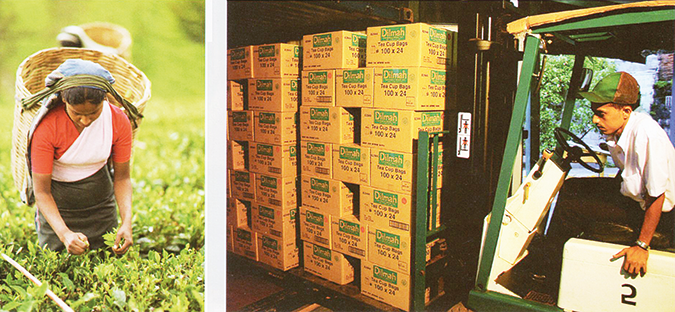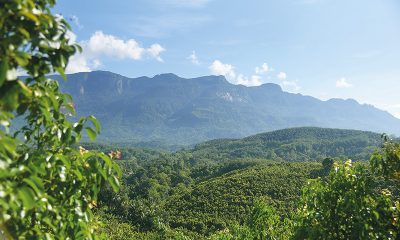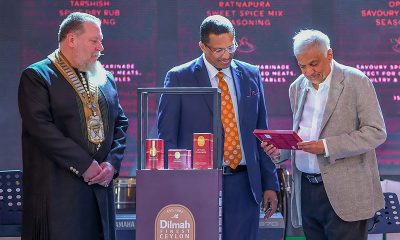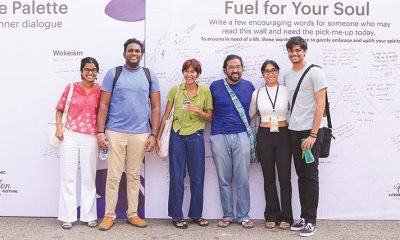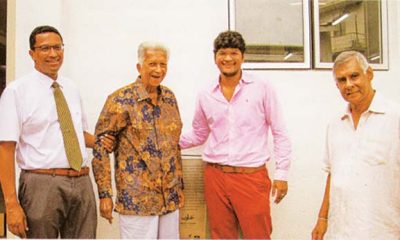Features
Dilmah, my personal ethos and my commitment to marketing a single origin Ceylon tea

(Excerpted from the Merrill J. Fernando autobiography)
Decades ago, before supermarket chains marketing international brands overwhelmed the consumers’ perception of quality, with marketing hyperbole surrounding mediocre products, it was the neighbourhood grocer running his own shop, who personally wrapped your goods and handed them over the counter. There was meaningful conversation between the two and the transaction implied immediate accountability of the supplier to the consumer.
Today that relationship has been replaced by the faceless and voiceless supermarket retailer, who supports a convenience lifestyle, but leaves no space for direct accountability for product quality.
Most of the currently popular global brands were first launched and developed by small, single entrepreneurs, with a passion for delivering a product with genuine value to the customer. Many of them led small- or medium-sized family companies, such as mine, which competed with each other on product quality, and not by price discounting. These were companies which had been in business for generations and, over time, nurtured their brands with great care and passion.
In time, many such brands, seduced by attractive take-over offers, sold out to massive corporate interests, which marketed the brands on their old, established value propositions, but debased the product in order to lower costs. That is the point at which a product with an intrinsic composite value of individuality and authenticity, becomes a boring, anonymous commodity, to be traded at the mass market label owners’ will.
The small- and medium-scale suppliers who concentrate on quality and the delivery of an authentic product to the consumer, at a commensurate price, were eventually forced out of business, in their inability to accept deep cost reductions whilst still maintaining product integrity. The concentration of the tea industry in the hands of multinationals, Global outreach, changed the priorities of the brands that they acquired from smaller companies.
The passion of the brand founder for authenticity and quality was replaced by the greed for profit, which often meant the debasement of quality. These altered priorities inevitably drove the new brand owners to progressively cheaper sources for tea, in the process sacrificing quality and stifling innovation. Consequently, what is ultimately delivered to the consumer is a commercially viable, low-quality product.
That is exactly what has happened to Ceylon Tea, in many parts of the world where it is still consumed; in the hands of the large multinational retailers, it has become commoditised. The ‘Pure Ceylon Tea’ label was first diminished to ‘Ceylon Blend,’ degraded further to `Ceylon Type,’ and eventually disappeared altogether. However, the customer, anesthetized to reality by the original value perception, and his judgment clouded by marketing make-believe and the hard-sell of attractively-wrapped fiction, continued to patronize the devalued product. Brand loyalty is one-sided. The multinational brand owner has no allegiance to the consumer or the product, but only to profit.
The massive consumption this system generated was followed by fierce competition for shelf space between different brands, leading to progressive lowering of quality by the packer, in order to manage production costs and to remain profitable. The power of multinational traders enabled them to dictate and manipulate the product price, whether it be tea or coffee. The core philosophy of big business is not to be better, but bigger and more profitable. It is an ugly culture in which there is no place for ethics, or the delivery of genuine value. It is an ethos which is certain to generate a race to the bottom, in which the winner is, inevitably, the least scrupulous.
One factor which worked in my favour then, and continues to do so today, was that when I launched Dilmah, it would have been the first time that a brand founder cum brand owner was making personal visits to the countries of consumption to promote his product. With my style of direct, personal marketing, I reintroduced the concept of the producer’s personal accountability to the consumer. I spoke to the consumer and also listened to him. If the product is genuine, the consumer will ensure the success of the brand.
Perhaps fortunately, I had neither studied marketing as a subject, nor ever read a book on marketing. Therefore, I relied on my instinct and the intimate personal knowledge of overseas tea marketing that I had gathered in over four decades up to that time. Those two factors have rarely failed me and they did not fail me in Australia. I knew enough about my product to answer any question on it, unlike a marketing or sales representative, who may not have had comprehensive knowledge of the product or, most importantly, a genuine passion for what he was selling.
Unlike a paid salesman, I was able to tell the potential buyer confidently, that my product was the best and explain why it was so. I talked and lived tea and was not simply selling it. Equally important, there was my unshakable belief that God helps those who strive with diligence and integrity.
As a small, single entrepreneur from a small country, both with limited resources, fighting against multinationals with seemingly-limitless advertising budgets and deep outreach across continents, I gradually came to realize that I had a matchless advantage when it came to product promotion. The multinational was a huge, faceless entity, with no morality and no allegiance to anybody or anything,
except to profit. There was no accountability between the supplier, seller, product, and consumer. It represented a callous, commercial chain with dis-empowered links.
Dilmah, on the other hand, had an intimate brand image, a face, a real man to that face and, behind that man, a real family. The consumer was able to relate his morning cup of tea to a flesh and blood person. It was a unique concept of integrated connectivity, from beginning to end. Dilmah was the only tea brand which provided genuine ‘Garden to Cup’ answerability. In its totality, it spoke of association, authenticity, and accountability, which are perceptions of unquantifiable worth in any relationship, whether it be personal or commercial.
My Dilmah was a dream, dreamt by me as a young man in his early twenties, at the very beginning of his career, serving a colonial master in a field hitherto inaccessible to Ceylonese. It took almost four decades for that dream to reach reality and fruition. That long journey was signposted by hope and despair, success and failure, and active assistance and deliberate sabotage. Finally, my perseverance prevailed, supported by an enduring faith in the inherent goodness of Pure Ceylon Tea, in my ability as a tea-maker, and in my God.
As a consequence of my direct approach and acceptance of personal responsibility for my brand, the buyers became my close friends and took me into their hearts and their homes. I got to know their families and they got to know mine. They understood that my concern for the quality of the product and its acceptance by the consumer genuinely superseded the profit motive.
My Unique Selling Point was that what I presented was garden fresh, unblended, Pure Ceylon Tea and of a genuinely single, and singular, origin. It was packed where it was grown. I was not just a seller or a marketer, or a middleman, selling a product he had no link to, but the head of a close-knit family, which was selling its own creation. I was also a messenger on behalf of a peerless product.
Marketing strategies and styles need to evolve constantly, in order to keep abreast of changing consumer patterns and competition from other products, the latter exerting relentless pressure on the seller of any brand or product. Similarly, with the introduction of electronic mass media and social media platforms delivering instant knowledge globally, my company has also been compelled to frequently adjust its marketing strategies, in order to respond effectively to such daunting challenges.
However, irrespective of the intensity of the contest and the rewards at stake, Dilmah has not, and will not, compromise on its founding principle of quality and purity. As I have said repeatedly in this writing, that core concept is immutable. I cannot say it often enough. Tradition is our bedrock and sustainability, with authenticity our goal. I do not believe in quick fixes to any problem, whether in life or in the marketing of tea.
At the time I launched Dilmah, ‘Ethical Trade’ and ‘Fair Trade’ were not the common currency of the marketing of tea, as they are today. The strength of Dilmah was its commitment to quality and authenticity, which is declared in every pack, supported by the family philosophy behind the brand. In a world of large traders, Dilmah was a farmers’ tea brand, overriding the middleman and going directly to supermarkets the world over.
We did not try to replicate the successful strategies of our larger competitors. We developed our own business concepts, designs, and packaging, whilst our marketing platform clearly reflected our family values and aspirations. Those were our unique selling points, and, in the end, they made the difference.
Dilmah is possibly the one internationally-marketed tea brand which buys its product only from the country where it is grown, and that which is owned, packed, and marketed by the same country, all within one family, with the revenue flowing back to the country of origin. The surplus from that trade also stays in the country of origin. It is that surplus which enables the Dilmah contribution to social justice, environmental conservation, and other worthy causes that benefit the community.
In my mind that is an enterprise model without peer. Well before the ‘Ethical Trade’ and ‘Fair Trade’ labels entered the formal marketing lexicon of the local and international tea trade, as either desirable attributes or mandatory requirements, Dilmah was already voluntarily compliant.
If there is a lesson in Dilmah, it is a very simple one. I followed a dream relentlessly, with passion and integrity, and shared it with my consumers. They listened to me because I was an ordinary man whom they could identify with, telling a story with a simple message that they could understand and believe in. My story never changed because it was a simple truth. I was successful in the delivery of that
message because I had total confidence in myself, a comprehensive knowledge of my product, and complete faith in divine guidance. The timely and happy confluence of those unvarnished verities invested the Dilmah story with the enduring resonance of sustainability and credibility, which are its greatest strengths.
Features
How many more must die before Sri Lanka fixes its killer roads?

On the morning of May 11, 2025, the quiet hills of Ramboda were pierced by the wails of sirens and the cries of survivors. A Sri Lanka Transport Board (SLTB) bus, en route from Kataragama to Kurunegala via Nuwara Eliya, veered off the winding road and plunged down a deep precipice in the Garandiella area. At least 23 people lost their lives and more than 35 were injured—some critically.
The nation mourned. But this wasn’t merely an isolated accident. It was a brutal reminder of Sri Lanka’s long-standing and worsening road safety crisis––one where the poor pay the highest price, and systemic neglect continues to endanger thousands every day.
A national epidemic
According to the Central Bank of Sri Lanka’s 2023 Road Safety Report, buses and other passenger vehicles are involved in 60% of fatalities while motorcycles account for 35% of reported accidents. Though three-wheelers are often criticised in the media, they contribute to only 12% of all accidents. The focus, however, remains disproportionately on smaller vehicles—ignoring the real danger posed by larger, state-run and private buses.
The Ramboda incident reflects what transport experts and road safety advocates have long warned about: that Sri Lanka’s road accident problem is not primarily about vehicle type, but about systemic failure. And the victims—more often than not—are those who rely on public transport because they have no other choice.
One of the biggest contributors to the frequency and severity of road accidents is Sri Lanka’s crumbling infrastructure. A 2023 report by the Sri Lanka Road Development Authority (SLRDA) noted that nearly 40% of the country’s road network is in poor or very poor condition. In rural and hilly areas, this figure is likely higher. Potholes, broken shoulders, eroded markings, and inadequate lighting are all too common. In mountainous terrain like Ramboda, these conditions can be fatal.
Even worse, since 2015, road development has effectively stagnated. Although the Mahinda Rajapaksa administration was often criticised for its ambitious infrastructure drive, it left behind a network of wide, well-lit highways and urban improvements. The subsequent administrations not only failed to continue this momentum, but actively reversed course in some instances—most notably, with the cancellation of the Light Rail Transit (LRT) project in Colombo, which had been poised to modernise urban mobility and reduce congestion.
Instead of scaling up, Sri Lanka scaled down. Maintenance budgets were slashed, long-term projects shelved, and development planning took a back seat to short-term political calculations. Roads deteriorated, traffic congestion worsened, and safety standards eroded.
Dangerous drivers
Infrastructure is only part of the story. Human behaviour plays a significant role too—and Sri Lanka’s roads often mirror the lawlessness that prevails off them.
A 2022 survey by the Sri Lanka Road Safety Council revealed alarming patterns in driver behaviour: 45% of accidents involved drivers under the influence of alcohol or drugs, and 40% were attributed to speeding. These figures reflect not just recklessness, but a dangerous culture of impunity.
The legal blood alcohol limit for drivers in Sri Lanka is 0.08%, but enforcement remains lax, particularly in rural areas and during off-peak hours. There is no consistent system of random breath testing, and police checkpoints are often limited to high-profile holidays or urban areas.
The same lack of enforcement applies to speeding, tailgating, overtaking on blind corners, and ignoring traffic signals. While the law technically provides for penalties, in practice, enforcement is selective at best. Even SLTB bus drivers—tasked with transporting hundreds daily—are known for aggressive and erratic driving. The Ramboda bus is reported to have been speeding on a dangerously narrow bend, a pattern that has become disturbingly common.
Public buses, both state-run and private, are some of the most dangerous vehicles on the road today—not just due to their size, but because of operational cultures that prioritise speed over safety. Competition for passengers, poor driver training, minimal vehicle maintenance, and weak regulatory oversight have created a deadly combination.
Do they not deserve better?
Most people who travel in SLTB buses are from lower-income backgrounds. They rely on public transportation not by choice, but by necessity. A factory worker in Nuwara Eliya, a schoolteacher in Bandarawela, or a daily wage earner commuting between towns—all are bound to a public transport system that is increasingly unreliable and unsafe.
Sri Lanka’s social contract has failed its most vulnerable. The poor are expected to brave substandard buses on crumbling roads, driven by underpaid and undertrained drivers, often in hazardous weather and terrain. In many rural areas, buses are lifelines. When one crashes, it is not merely a tragedy—it’s a profound injustice.
Had the LRT system gone forward, had road maintenance been prioritised, had reckless drivers been reined in through strict enforcement, how many lives could have been saved?
Experts agree that the solution lies in a combination of infrastructure investment, driver education, and law enforcement reform. The Sri Lanka Road Safety Council has repeatedly called for mandatory road safety training, particularly for commercial drivers. Such training should cover not just traffic laws, but also defensive driving, fatigue management, and the dangers of DUI.
Enforcement, too, needs a dramatic overhaul. License suspensions, large fines, and jail time for repeat offenders must become the norm—not the exception. A centralised traffic violation database could prevent habitual offenders from slipping through the cracks.
And critically, investment in infrastructure must resume—not in flashy mega-projects for political gain, but in safe, functional, and equitable roads and transit systems. The re-introduction of the LRT or similar mass transit projects should be seriously reconsidered, especially in urban centers where congestion is growing and road space is limited.
The misunderstood three-wheeler
On the other hand, while three-wheelers are frequently vilified in public discourse and media narratives for reckless driving, the data tells a different story. According to the Central Bank’s 2023 Road Safety Report, they account for just 12% of all road accidents—a fraction compared to the 60% involving buses and other passenger vehicles, and the 35% attributed to motorcycles. Yet, disproportionate attention continues to be directed at three-wheelers, conveniently shifting focus away from the far greater risks posed by large, state-run and private buses.
What often goes unacknowledged is the essential role three-wheelers play in Sri Lanka’s transport ecosystem, particularly in remote and rural areas where reliable public transport is virtually nonexistent. For residents of small towns and isolated villages in the hill country, three-wheelers are not a luxury—they are a necessity. Affordable, nimble, and capable of navigating narrow, winding roads where buses cannot operate, these vehicles have become the primary mode of short-distance travel for countless Sri Lankans.
Even more importantly, in the aftermath of road accidents—especially in remote regions like Ramboda—it is often the three-wheeler drivers who are the first to respond. When tragedy strikes, they ferry the injured to hospitals, assist with rescue efforts, and offer immediate aid long before official emergency services arrive. This community-centered, grassroots role is rarely acknowledged in national conversations about road safety, yet it remains a vital, life-saving contribution.
Rather than treating three-wheelers as a problem to be blamed, the government should recognise their indispensable value and work towards integrating them more effectively and safely into the national transport framework. Regularising the sector through measures such as mandatory driver training programmes, periodic vehicle safety checks, and the enforcement of standardised operating licenses could improve safety without displacing an essential service. Additionally, designating official three-wheeler stands, particularly in high-risk or high-traffic areas, and incentivising drivers who maintain clean safety records would help create a safer, more accountable environment for both passengers and pedestrians.
Moving beyond the blame game
It is time for us to move beyond the tired narrative that blames specific vehicles—motorcycles, three-wheelers, or buses—for the carnage on Sri Lanka’s roads. The problem is not the mode of transport. It is the system that surrounds it.
When buses are poorly maintained, roads are not repaired, drivers are not trained, and laws are not enforced, tragedy becomes inevitable. Blaming a single vehicle type does nothing to address these root causes.
The real question is: Do we have the political will to fix this? Or will Sri Lanka continue to count the dead—accident after accident—while doing little more than issuing condolences?
The Ramboda accident was not the first. It won’t be the last. But it should be the turning point.Let this be the moment we stop pointing fingers—and start fixing the road.
(The writer is an Attorney-at-Law with over a decade of experience specializing in civil law, a former Board Member of the Office of Missing Persons, and a former Legal Director of the Central Cultural Fund. He holds an LLM in International Business Law and resides in Battaramulla, where he experiences the daily challenges of commuting to Hulftsdorp, providing him with a unique perspective on Sri Lanka’s road safety issues.)
By Sampath Perera
Features
J’accuse – Need for streamlined investigation of corruption in former President’s office

Though the government is moving more slowly on corruption than I would have liked, it is moving, which is more than can be said for its predecessors. I remember how sad I was when Yahapalanaya did very little, except for political advantage, about the corruption it had highlighted in the election campaign in which I had so foolishly joined; but the reason became clear with the bond scam, when the Ranil Wickremesinghe administration rose to heights of corruption that surpassed, in convoluted ingenuity, anything the Mahinda Rajapaksa government could have achieved. Thus far the present government is clean, and that will make its task much easier.
I hope then that the slow but steady progress of this government in investigation will bear fruit. But at the same time, I think it would also be good if it looked at instances when corruption was avoided. The horrors of the visa scam, in which the Controller General of Immigration seems to have connived with his political masters, suggest how important it is to also praise those civil servants who resist pressures.
With regard to the visa scam, I had thought Tiran Alles largely responsible, but perhaps I have done the man an injustice – if that were conceivable – and the fountainhead of the matter was the President. I now think this the more likely, having heard about a Civil Servant who did stand up against the political pressures brought upon him. If this government were to look into the matter, and recognise his integrity and courage, perhaps that would prompt the former Controller General of Immigration and Emigration too to come clean and turn Crown Witness, having accepted a compounded penalty for anything he might have done wrong.
It can be difficult to resist pressure. That must be understood though it is no reason to excuse such conduct. But it is therefore more essential to praise the virtuous, such as the former Secretary to the Ministry of Health, Dr Palitha Mahipala. I had heard of him earlier, and I am sorry he was removed, though I have also heard good things about his successor, so there is no reason to bring him back. But perhaps he could be entrusted with greater responsibilities, and awarded some sort of honour in encouragement of those with courage.
One of the notable things Dr Mahipala did was to resist pressure brought upon him to award a contract to Francis Maude, a British crony of the President. This was to design a supply chain management for pharmaceuticals. A system for this was already being designed by the Asian Development Bank, but when told about this the authorities had nevertheless insisted.
The then Secretary to the Prime Minister cannot absolve himself of the responsibility for having asked the Ministry of Health to prepare a stunningly expensive MoU that was quite unnecessary.
But his claim was that he had been introduced to the Britisher by a top aide of the President. This rings true for it was the President who first wished Maude upon the country. It was after all Ranil Wickremesinghe who, a year after he became President, announced that, to boost state revenue, Maude had been invited ‘to visit Sri Lanka and share his insights on sectoral reform’.
When he became a Minister under David Cameron, Maude’s responsibilities included ‘public service efficiency and transparency’. There seems to have been nothing about revenue generation, though the President’s statement claimed that ‘Sri Lanka must explore new avenues for increasing income tax revenues…He expressed concern over not only the neglect of public revenue but also the unrestricted spending of public funds on non-beneficial activities’.
He ‘called for an extensive media campaign to educate the public’ but this did not happen, doubtless because transparency went by the board, in his antics, including the demand, whoever prompted it, that Maude be to do something already done. Surely, this comes under the heading of unrestricted spending of public funds on non-beneficial activities, and it is difficult to believe that top government officials connived at promoting this while Ranil would have expressed concern had he known what they were up to.
Nothing further is recorded of Ranil’s original trumpeting of Maude’s virtues, and far from being there to provide advice on the basis of his experience in government, he seems to have been trawling for business for the firm he had set up on leaving politics, for it was with that private agency that the MoU was urged.
Thankfully, Dr Mahipala resisted pressure, and that plot came to nothing. But it should not be forgotten, and the government would do well to question those responsible for what happened, after speaking to Dr Mahipala and looking at the file.
Indeed, given the amount of corruption that can be traced to the President’s Office, it would make sense for the government to institute a Commission of Inquiry to look into what happened in that period of intensive corruption. It should be subject to judicial appeal, but I have no doubt that incisive questioning of those who ran that place would lead to enough information to institute prosecutions, and financial recompense for the abuses that occurred.
by Prof. Rajiva Wijesinha
Features
Trump’s Press Secretary; no attention to the health crisis

 In her Cry on 25 April, Cassandra wrote this in her section on Trump’s moves to Make America Great Again – MAGA. “The latest was heard on BBC news on Wednesday 16. A fluff of a blonde White House press secretary by name of Karoline Leavitt announces that President Trump expects Harvard University to apologise to him for the continuing tolerance of anti-Semitism by the university. And that little blonde fluff adds ‘And they should.’ Didn’t Cass guffaw, but bitterly. That’s Trump vs Harvard.”
In her Cry on 25 April, Cassandra wrote this in her section on Trump’s moves to Make America Great Again – MAGA. “The latest was heard on BBC news on Wednesday 16. A fluff of a blonde White House press secretary by name of Karoline Leavitt announces that President Trump expects Harvard University to apologise to him for the continuing tolerance of anti-Semitism by the university. And that little blonde fluff adds ‘And they should.’ Didn’t Cass guffaw, but bitterly. That’s Trump vs Harvard.”
Karoline Leavitt
This young blonde has been making waves ever since, so much so that night shows in the US have spoken of her, and not well. Jimmy Kimmel arranged a dialogue between Karoline and Mark Carney, PM of Canada, when he recently visited the US. She insulted him by saying he did not know what democracy was and that Canada would benefit by becoming the 51st of the US. Carney vowed Canada was not for sale and never would be. The interview which was described in a video which I watched got hotter, Carney became cooler and Karoline rattled until she shot up and left the room. The usually noisy crowd that collects to listen to Kimmel roared – disdain.
Cass had to ferret more about her, so she went to the Internet. Born in 1997, Karoline Leavitt studied politics and communication at Saint Anselm College, which she entered on a games scholarship. She interned in the White House as an apprentice press secretary and was named a press secretary in Trump‘s first term. After Trump’s loss in 2020, she became a communications director for New York. She was the Republican candidate in the US House of Reps election for New Hampshire in 2022 but lost. She was much in Trump’s campaign against Biden’s winning and then served as a spokeswoman for MAGA Inc. In November 2024, Trump named her his White House Press Secretary, the youngest to hold this post in US history. All this seems to have gone to her blonde head!
Mosquitoes making life hell in Colombo
These pests are breeding like mad in and around Colombo and other parts of the country too. We can be tolerant of nature and its creatures, but the mosquito now is deadly. She passes on the dreaded diseases of chikungunya and dengue; the former debilitating for months after the grueling ache in bones is abated as the infection recedes. Dengue can be fatal if one’s platelet count goes below the red line.
The crux of the near pandemic of these two diseases is that infection and prevalence of the two could be greatly reduced by control of the carrier of the infection – The Mosquito. And on whom rests the responsibility of controlling the breeding of mosquitoes? On You and Me. But both of these entities are often careless, and totally non-caring about keeping their premises clean and of course eliminating all breeding spots for flying pests. Does the responsibility end there? Not upon your life! The buck moves on and lands on the public health inspectors, the garbage removers, the fumigators. Their boss who sees to them working properly is the Medical Officer of Health. And he is part of the Colombo Municipal Council that has the responsibility of looking to the health of people within the MC.
The spread of the two diseases mentioned is proof that the above persons and establishments are NOT doing the work they should be doing.
It is a proven fact that just before a change in personnel in the country, or a MC or a Pradeshiya Sabha, with a general election or local government election in the near future, most work stops in government offices or in local government establishments as the case may be. Workers get the disease of ennui; do minimum work until new bosses take over.
This definitely has happened in Colombo. Cass lives in Colombo 3. Quite frequent fumigation stopped some time ago. About two weeks ago she heard the process and smelled the fumes. Then nothing and mosquitoes breeding with the infrequent rain and no repellents or cleaning of premises. She phoned the MOH’s office on Thursday last week. Was promised fumigation. Nothing.
We are in a serious situation but no Municipal Council action. Politics is to blame here too. The SJB is trying to grab control of the Colombo MC and people are falling prey to the two diseases. All politicians shout it’s all for the people they enter politics, etc. The NPP has definitely shown concern for the public and have at least to a large extent eliminated corruption in public life. They have a woman candidate for Mayor who sure seems to be able to do a very good job. Her concern seems to be the people. But no. A power struggle goes on and its root cause: selfishness and non-caring of the good of the people. And for more than a week, the personnel from the MOH are looking on as more people suffer due to dirty surroundings.
Garbage is collected from her area on Tuesdays and Saturdays with paper, etc., on Thursdays. Tuesday 13 was a holiday but garbage was put out for collection. Not done. At noon, she phoned a supervisor of the cleaning company concerned only to ask whether the workers had a day off. Garbage was removed almost immediately. That is concern, efficiency and serving the public.
As Cass said, Colombo is in near crisis with two mosquito borne diseases mowing down people drastically. And nothing is being done by the officers who are given the responsibility of seeing to the cleanliness of the city and its suburbs.
-

 Features7 days ago
Features7 days agoSAITM Graduates Overcome Adversity, Excel Despite Challenges
-

 Opinion7 days ago
Opinion7 days agoDrs. Navaratnam’s consultation fee three rupees NOT Rs. 300
-

 News7 days ago
News7 days agoDestined to be pope:Brother says Leo XIV always wanted to be a priest
-

 Sports7 days ago
Sports7 days agoASBC Asian U22 and Youth Boxing Championships from Monday
-

 Features6 days ago
Features6 days agoChampioning Geckos, Conservation, and Cross-Disciplinary Research in Sri Lanka
-

 Business7 days ago
Business7 days agoDilmah – HSBC future writers festival attracts 150+ entries
-

 Midweek Review4 days ago
Midweek Review4 days agoBronze statue for P’karan, NPP defeat in the North and 16th anniversary of triumph over terrorism
-

 News2 days ago
News2 days agoChikungunya spreading rapidly in Colombo and suburbs



